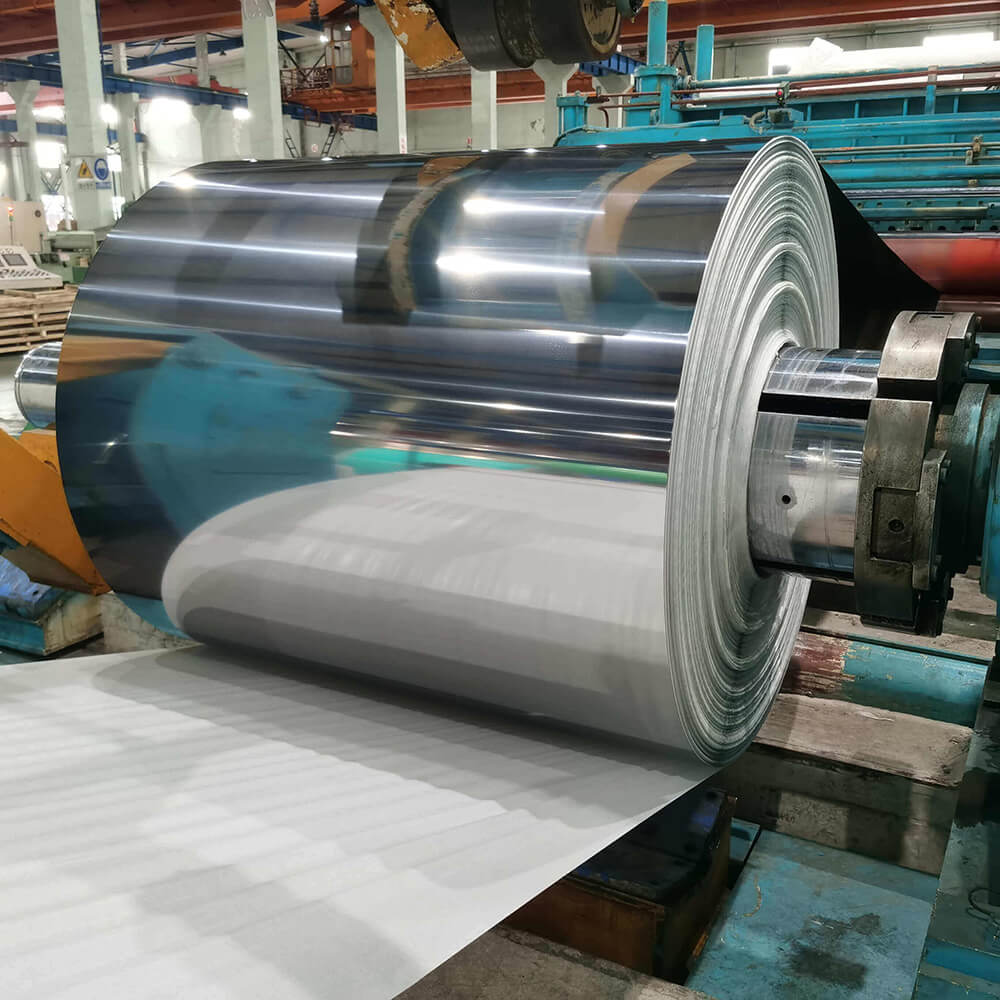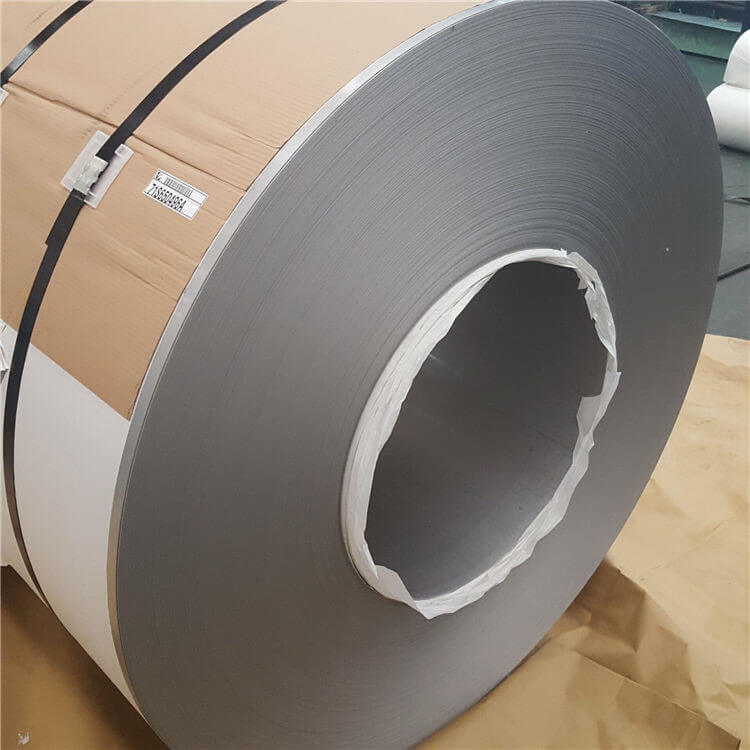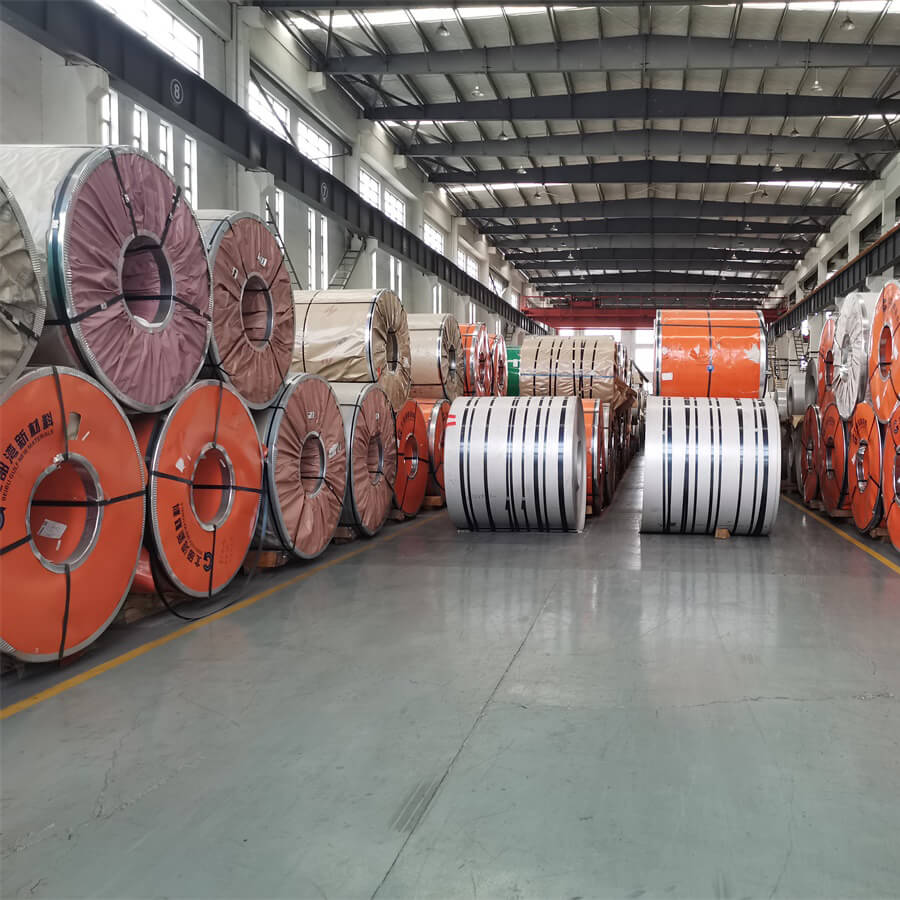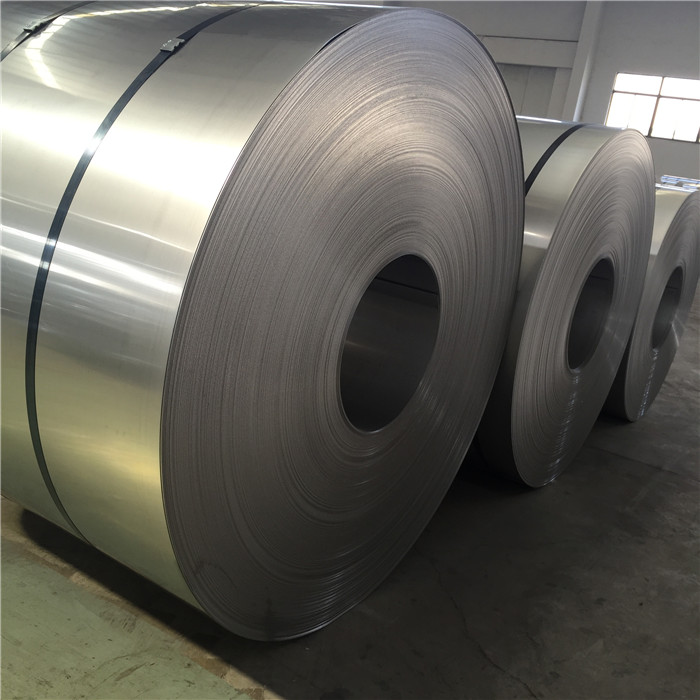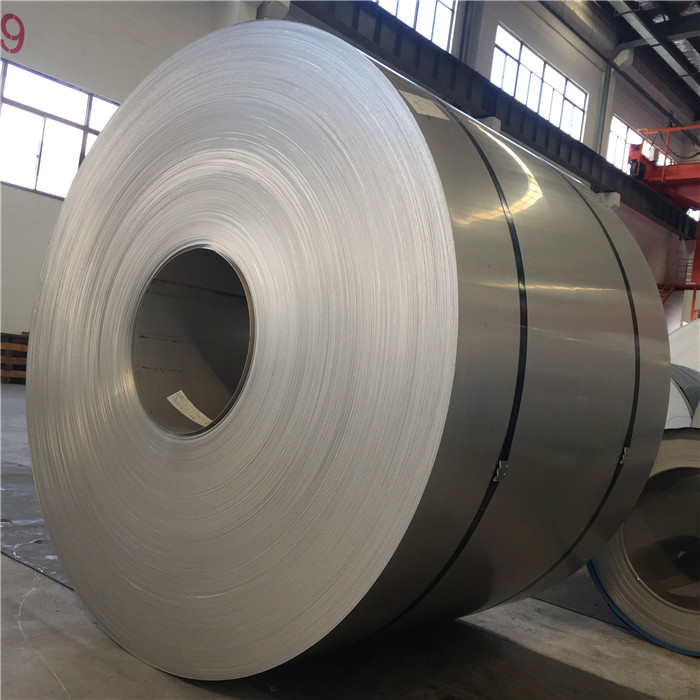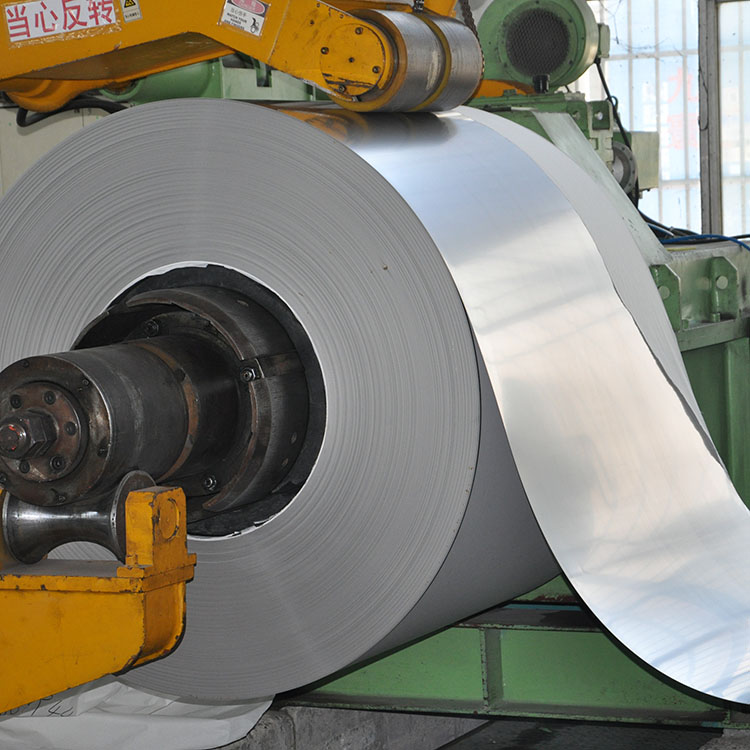201 Stainless Steel Coil :
The 200 series stainless steel was first developed in the United States during World War II as a substitute for the 300 series stainless steel.
At that time, because of the war, nickel as a strategic material was strictly controlled by the countries concerned, and the supply of nickel in the United States was seriously short.
This new series of austenitic stainless steels with manganese instead of nickel was developed in the United States in order to solve the problem of production and supply of stainless steel under the condition of severe nickel shortage.
After the end of World War II, the supply of nickel in the United States gradually improved, so the production of 300 series stainless steel is no longer restricted by raw material constraints, so the 200 series did not get a big development.
Several original participation in the development of 200 series of stainless steel Indians, after returning to India, from India is a relatively rich in manganese resources, nickel resources lack of national conditions, will be developed in the United States 200 series of stainless steel varieties back to India.
The success of the 200 series stainless steel in India is due to the possibility of replacing 304 stainless steel in some specific applications.
Most of the 200 series stainless steels sold in the Chinese market have little control on sulfur and carbon content according to national standards, and use manganese (and nitrogen) to replace part or all of nickel to produce austenitic stainless steels with lower nickel content.
The disadvantage of this series of materials is: below 18% chromium content and low nickel content can not reach balance and form ferrite, for this reason, 200 series of stainless steel chromium content to 13.5% ~ 15%, in some cases down to 13% ~ 14%, its corrosion resistance is not compared with 304 and other similar steels.
In addition, manganese and, in some cases, copper reduce the effect of re-passivation under acidic conditions common in the corrosion sites of deposits and crevasses.
The destruction rate of 200 series steels under these conditions is approximately 10-100 times that of 304 stainless steels.
The residual sulfur and carbon content of these steels is often not controlled during production, and the material cannot be traced to its source, even when it is recycled.
If Cr-Mn steels are not specified, they can become a dangerous scrap mix, resulting in castings containing unexpectedly high levels of manganese.
This is the most cost effective grade of steel. So the 201 Stainless Steel coil Price is lower compared to other grades of stainless steels and all metallic products in general. There are different versions of the material with low carbon and high carbon content. The low carbon version, 201 coils are very good for welding applications as they have less carbide precipitation and less localized corrosion.
| Grade | Euronorm | China GB | Japanese JIS | |
| No. | ||||
| 201 | 1.4372 | 12Cr17Mn6Ni5N | SUS201 | |
Stainless Steel 201 Chemical Comppsition :
| Grade | C | Mn | Si | P | S | Cr | Mo | Ni | N | |
| 201 | Min. Max. | ≤0.15 | 5.5~7.50 | ≤1.00 | ≤0.060 | ≤0.03 | 16.0~18.0 | / | 3.5-5.5 | ≤0.25 |
Tensile strength :520MPa
Yield strength :275MPa
Elongation :55 to 60%
Elastic modulus :29,000,000 psi is equivalent to: 203000MPa
Hardness requirement (Brinell hardness)
183 n/was (MPa).
Density :.280 LBS /cubic inch(density 7.93g/cm3)
202 Stainless Steel Coil :
202 stainless steel is one of the 200 series stainless steel, the national standard model is 1Cr18Mn8Ni5N.
200 series stainless steel belongs to low nickel and high manganese stainless steel, nickel content, manganese content of about 8%, is a section of nickel stainless steel.
This is the most cost effective grade of steel. So the 202 Stainless Steel coil Price is lower compared to other grades of stainless steels and all metallic products in general. There are different versions of the material with low carbon and high carbon content. The low carbon version, 202 coils are very good for welding applications as they have less carbide precipitation and less localized corrosion.
| Grade | Euronorm | China GB | Japanese JIS | |
| No. | ||||
| 202 | 1.4373 | 1Cr18Mn8Ni5N | SUS202 | |
Stainless Steel 202 Chemical Comppsition :
| Grade | C | Mn | Si | P | S | Cr | Mo | Ni | N | |
| 202 | Min. Max. | ≤0.15 | ≤7.5~10.0 | ≤1.00 | ≤0.060 | ≤0.03 | 17.0~ 19.0 | / | 4.00~ 6.00 | ≤0.25 |
Product advantage
1. Environmental protection: It can effectively reduce environmental pollution.
2. Corrosion resistance: stain resistance, acid resistance, corrosion resistance, wear resistance, no radioactivity.
3. Surface cleaning: the surface of the product is smooth and compact, not easy to be polluted by dust, with good self-cleaning.
4. Easy maintenance: Easy to repair minor damage.
304 Stainless Steel Coil :
The thinner coils have higher strength values. The specification of the coils is the A240 for pressure vessel and high temperature applications. The ASTM A240 SS 304 coil can withstand high temperatures up to 870 degrees Celsius. The coils are used for this reason in evaporators, heat exchangers and in other high temperature applications. The Stainless Steel 304 coil is also used in drums, barrels, dairy equipment, food processing and in hospital equipment.
This is the most cost effective grade of steel. So the 304 Stainless Steel coil Price is lower compared to other grades of stainless steels and all metallic products in general. There are different versions of the material with low carbon and high carbon content. The coils and UNS S30400 Stainless Steel Strip Specification varies and the applications differ for the different versions of the material. The low carbon version, 304L coils are very good for welding applications as they have less carbide precipitation and less localized corrosion. The ASME SA240 Stainless Steel 304 Coil Thickness ranges up to 200mm and the width and the length ranges widely depending on the application requirements as well. Please contact us for more information and prices.、
Stainless steel is a kind of alloy steel, with smooth surface, high weldability, corrosion resistance, polishing, heat resistance, corrosion resistance and other characteristics. It is widely used in various industries and is an important material in modern industry. Stainless steel is divided into stainless steel, iron oxygen stainless steel, Martengsitt stainless steel and duplex stainless steel by structural state.
| Grade | UNS No. | Old British | Euronorm | China GB | Japanese JIS | ||
| BS | EN | No. | Name | ||||
| 304 | S30400 | 304S15 | 58E | 1.4301 | X5CrNi18-10 | 0Cr18Ni9 | SUS304 |
Stainless Steel 304 Chemical Comppsition :
304L Stainless Steel Coil :
304L stainless steel is a kind of universal stainless steel material.
304L stainless steel grade:
The old standard JB/T 4237-1992 corresponds to 00Cr19Ni10
New standard GB/T 20878-2007 Stainless steel and heat resistant steel grades and chemical composition
And GB 24511 2009 stainless steel coils and strips for pressure bearing equipment
The above corresponds to 022Cr19Ni10, which contains about 0.03% carbon
Uniform digital code S30403 is different from S30408 of 304
This is the most cost effective grade of steel. So the 304L Stainless Steel coil Price is lower compared to other grades of stainless steels and all metallic products in general. There are different versions of the material with low carbon and high carbon content. The low carbon version, 304L coils are very good for welding applications as they have less carbide precipitation and less localized corrosion.
Stainless steel is a kind of alloy steel, with smooth surface, high weldability, corrosion resistance, polishing, heat resistance, corrosion resistance and other characteristics. It is widely used in various industries and is an important material in modern industry. Stainless steel is divided into stainless steel, iron oxygen stainless steel, Martengsitt stainless steel and duplex stainless steel by structural state.
| Grade | Euronorm | China GB | Japanese JIS | |
| No. | ||||
| 304L | 1.4307 | 00Cr19Ni10 | SUS304L | |
Stainless Steel 304L Chemical Comppsition :
| Grade | C | Mn | Si | P | S | Cr | Mo | Ni | N | |
| 304L | Min. Max. | ≤0.03 | ≤2.0 | ≤1.00 | ≤0.045 | ≤0.03 | 18.0~20.0 | / | 9.0~12.0 | |
Yield strength (N/mm2) ≥205
Tensile strength ≥520
Elongation rate (%) ≥40
Hardness HB ≤187 HRB≤90 HV ≤200
The density of 7.93 g · cm - 3
Specific heat c (20 ℃) 0.502 j. (g · c) - 1
Thermal conductivity λ/W(m·℃)-1 (at the following temperatures /℃)
20 100 500
12.1 16.3 21.4
Linear expansion coefficient α/(10-6/ ° C) (at / ° C between the following temperatures)
20 ~ 200 20 ~ 300 20 ~ 400
16.0 16.8 17.5 18.1
Resistivity 0.73 Ω·mm2·m-1
Melting point 1398 ~ 1420℃
316 Stainless Steel Coil :
316 stainless steel because of the addition of Mo element, so that its corrosion resistance, and high temperature strength has been greatly improved, high temperature resistance can reach 1200-1300 degrees, can be used under harsh conditions.
Application: Seawater equipment, chemical, dye, paper making, oxalic acid, fertilizer and other production equipment;
Photographs, food industry, coastal facilities, ropes, CD rods, bolts, nuts.
Characteristics: Because of the addition of Mo, it has good corrosion resistance, atmospheric corrosion resistance and high temperature strength, which can be used under harsh conditions;
Excellent work hardening (non-magnetic);
Excellent high temperature strength;
The solid solution state is not magnetic;
Cold rolled product appearance gloss is good, beautiful;
Relative to 304 stainless steel, the price is higher.
316 stainless steel because of the addition of Mo element, so that its corrosion resistance, and high temperature strength has been greatly improved, high temperature resistance can reach 1200-1300 degrees, can be used under harsh conditions.
Application: Seawater equipment, chemical, dye, paper making, oxalic acid, fertilizer and other production equipment;
Photographs, food industry, coastal facilities, ropes, CD rods, bolts, nuts.
| Grade | Euronorm | China GB | Japanese JIS | |
| No. | ||||
| 316 | 1.4401 | 0Cr17Ni12Mo2 | SUS316 | |
Stainless Steel 316 Chemical Comppsition :
| Grade | C | Mn | Si | P | S | Cr | Mo | Ni | N | |
| 316 | Min. Max. | ≤0.08 | ≤2.00 | ≤1.00 | ≤0.035 | ≤0.03 | 16.0-18.5 | 2.0-3.0 | 10.0-14.0 | |
The tensile strength (MPa) was 620 MIN
The yield strength (MPa) was 310 MIN
Elongation rate (%) 30 MIN
Area reduction (%) 40 MIN
316L Stainless Steel Coil :
316L has a wide range of applications in the chemical industry because of its excellent corrosion resistance. 316L is also a derivative of 18-8 austenitic stainless steel, with 2 ~ 3% Mo element added.
On the basis of 316L, many kinds of steel are also derived. For example, 316Ti is derived after adding a small amount of Ti, 316N is derived after adding a small amount of N, and 317L is derived by increasing the content of Ni and Mo.
Most of the existing 316L in the market are produced according to American standards.
For cost consideration, steel mills generally put the Ni content of products as far as possible by the lower limit.
The American standard stipulates that the Ni content of 316L is 10 ~ 14%, while the Japanese standard stipulates that the Ni content of 316L is 12 ~ 15%.
According to the minimum standard, there is a 2% difference between the American standard and Japanese standard in the Ni content, which is still quite huge in the price. Therefore, customers still need to see clearly when buying 316L products, whether the products refer to ASTM or JIS standards.
The Mo content of 316L makes the steel have excellent pitting resistance and can be safely used in environments containing Cl- and other halogen ions.
Because 316L is mainly used for its chemical properties, steel mills have slightly lower requirements for surface inspection of 316L (relative to 304), and customers with higher surface requirements should strengthen surface inspection.
| Grade | Euronorm | China GB | Japanese JIS | |
| No. | ||||
| 316L | 1.4404 | 022Cr17Ni12Mo2 | SUS316L | |
Stainless Steel 316L Chemical Comppsition :
| Grade | C | Mn | Si | P | S | Cr | Mo | Ni | N | |
| 316L | Min. Max. | ≤0.03 | ≤2.00 | ≤1.00 | ≤0.045 | ≤0.03 | 16.00~18.00 | 2.00~3.00 | 10.00~14.00 | |
Tensile strength σb (MPa) : ≥480
Conditional yield strength σ0.2 (MPa) : ≥177
Elongation Δ5 (%) : ≥40
Section shrinkage ψ(%) : ≥60
Hardness: 187 hb or less;
90 HRB or less;
200 hv or less
Density: 7.98g/cm3;
Specific heat capacity ratio (20℃) : 0.502J/(g*K)
309S Stainless Steel Coil :
309S corresponding to the Chinese brand is 0Cr23Ni13, the American standard S30908 (AISI, ASTM) characteristics and use: corrosion resistance, heat resistance are better than 0Cr19Ni9.
The 309S is a variant of the lower carbon 309 stainless steel for use where soldering is required.
The lower carbon content minimizes the precipitation of carbides in the heat affected zone near the weld, which may lead to intergranular corrosion (welding erosion) of stainless steel in some environments.
It can withstand repeated heating below 980 ℃, and has high high temperature strength, oxidation resistance and carburizing resistance.
Application: Furnace material.
Widely used in boilers, energy (nuclear power, thermal power, fuel cell), industrial furnaces, incinerators, heating furnaces, chemical, petrochemical and other important fields.
Stainless steel is a kind of alloy steel, with smooth surface, high weldability, corrosion resistance, polishing, heat resistance, corrosion resistance and other characteristics. It is widely used in various industries and is an important material in modern industry. Stainless steel is divided into stainless steel, iron oxygen stainless steel, Martengsitt stainless steel and duplex stainless steel by structural state.
| Grade | Euronorm | China GB | Japanese JIS | ASTM | |
| No. | |||||
| 309S | 1.4950 | 0Cr23Ni13 | SUS309S | S30908 | |
Stainless Steel 309S Chemical Comppsition:
Yield strength/Mpa: ≥ 205
Tensile strength /MPa: ≥515
Elongation /% : ≥ 40
Section reduction rate /% : ≥50
310S Stainless Steel Coil :
310S stainless steel is austenitic chromium-nickel stainless steel, has good oxidation resistance, corrosion resistance, high temperature resistance, because of the higher percentage of chromium and nickel, making it has much better creep strength, can continue to work at high temperature, has good high temperature resistance.
Because of the high content of nickel (Ni), chromium (Cr), has good oxidation resistance, corrosion resistance, acid and alkali resistance, high temperature resistance, high temperature resistant steel pipe is dedicated to the manufacture of electric furnace tube and other occasions, austenitic stainless steel increases the content of carbon, due to its solid solution strengthening effect so that the strength is improved,
The austenitic stainless steel has high strength and creep strength at high temperature due to its face-centered cubic structure, which is based on chromium and nickel.
Melting point 1470℃, 800℃ began to soften, allowable stress continued to reduce.
Improve the common carbon tool steels brittle nature, and to extend the life of tools.
Vacuum degassing refining steel, stable quality.
Good hardenability, oil cold hardening (quenching and deformation less) good toughness and wear resistance, durable tools.
Stainless steel is a kind of alloy steel, with smooth surface, high weldability, corrosion resistance, polishing, heat resistance, corrosion resistance and other characteristics. It is widely used in various industries and is an important material in modern industry. Stainless steel is divided into stainless steel, iron oxygen stainless steel, Martengsitt stainless steel and duplex stainless steel by structural state.
| Grade | Euronorm | China GB | Japanese JIS | |
| No. | ||||
| 310S | 1.4951 | 06Cr25Ni20 | SUS310S | |
Stainless Steel 310S Chemical Comppsition :
| Grade | C | Mn | Si | P | S | Cr | Mo | Ni | N | |
| 310S | Min. Max. | ≤0.08 | ≤2.0 | ≤1.5 | ≤0.035 | ≤0.03 | 24.00-26.00 | / | 19.00-22.00 | |
Ob (MPa) 520 or higher, o0.2 (MPa) 205 or higher, the delta 5 (%) of 40 or higher, Ψ (%) of 50 or more, HB 187 or less can withstand temperatures up to 1150 ℃.
Melting point at 1398 ℃ ~ 1454 ℃
Tempering: 180 ~ 200
Annealing condition, ≤207HB, indentation diameter ≥4.20mm
Quenching, p 62 HRC
321 Stainless Steel Coil:
Austenitic stainless steel equivalent to domestic grade 0Cr18Ni10Ti 321 stainless steel is Ni-Cr-Mo type austenitic stainless steel, its performance is very similar to 304, but due to the addition of titanium, so that it has a better resistance to grain boundary corrosion and high temperature strength.
Due to the addition of titanium, the formation of chromium carbide is effectively controlled.
321 austenitic stainless steel has good corrosion resistance in the atmosphere, and is widely used in petrochemical, electric power, bridge and automobile industries.
But the stainless steel "rust" is not absolute, because of the special service environment, stainless steel will also occur corrosion.
Medium concentration, pH value, temperature and other factors will have a greater impact on the corrosion resistance of stainless steel.
For example, in the range of 450~850℃ sensitization temperature long-term use, stainless steel will occur intergranular corrosion.
The mechanism is that C combines with Cr at grain boundary to form Cr23C6 and precipitates out, which reduces Cr content at grain boundary, which is the so-called "poor chromium".
The Cr element is one of the main elements to inhibit the intergranular corrosion. When the Cr content at the grain boundary is less than 12%, the probability of intergranular corrosion will increase.
| Grade | Euronorm | China GB | Japanese JIS | Germany | |
| No. | |||||
| 321 | 1.4541 | 0Cr18Ni10Ti | SUS321 | X10CrNiTi189 | |
Stainless Steel 321 Chemical Comppsition :
Alloys 321 and 347 have similar resistance to general corrosion as the unstable Ni-Cr 304.
Prolonged heating in the temperature range of the chromium carbide degree may affect the corrosion resistance of alloys 321 and 347 in harsh corrosive media.
The corrosion resistance of the two alloys is similar in most environments;
However, the corrosion resistance of the annealed alloy 321 in the strong oxidizing environment is slightly lower than that of the annealed alloy 347.
Alloy 347 is therefore superior in water and other low temperature environments.
When exposed to the temperature range from 800°F to 1500°F (427°C to 816°C), the overall corrosion resistance of alloy 321 is much worse than that of alloy 347.
Alloy 347 is primarily used for high temperature applications where strong resistance to sensitization is required to prevent intergranular corrosion at lower temperatures.
409L Stainless Steel Coil :
With its excellent corrosion resistance, 409L stainless steel is suitable for prolonging the life of automobiles and lightening the weight of automobiles. As an environmentally friendly material for recycling, GM, Ford, Volkswagen, DaimlerChrysler and other major automobile manufacturers adopt 100% stainless steel in their exhaust systems.
Automobile exhaust system will be produced by the automobile engine high temperature, high speed combustion exhaust gas processing, it discharged outside the car.
The main function of the exhaust system is to reduce vibration and noise, and to convert the exhaust gas into a clean gas after it is reburned.
The automobile exhaust system is the longest part of the automobile parts, the system to withstand great temperature changes (-20 ~ 850℃) and high temperature, high speed exhaust gas of high frequency vibration, and in the car the largest change, the most complex environment, 409L can withstand the temperature limit of (-20 ~ 650℃).
Recently, due to environmental protection on the automobile exhaust standards increasingly strict, short distance urban driving increase, winter snow removal agent spread and other reasons, the use of exhaust system standards are increasingly strict, from the European Ⅱ- European standard, the traditional steel can not meet its technical requirements, high-end motorcycle exhaust system has been used 409L material.
The amount of 409L stainless steel used for each vehicle is 35KGS-65KGS.
409L high temperature resistance, can achieve high efficiency of the engine and exhaust system, and reduce the thickness of the exhaust system, can reduce exhaust emissions.
409L low cost, good flexibility, high rate of finished material, easy to replace, belongs to the environmental protection of new products.
| Grade | Euronorm | Japanese JIS | ISO | |
| No. | ||||
| 409L | 1.4512 | SUH409L | X2CrTi12 | |
Stainless Steel 409L Chemical Comppsition :
410S Stainless Steel Coil :
1) High strength;
2) Excellent machinability
3) Hardened after heat treatment;
4) Magnetic;
5) not suitable for harsh corrosive environment.
Scope of application
General blade, mechanical parts, class 1 tableware (spoon, fork, knife, etc.).
This is the most cost effective grade of steel. So the 410S Stainless Steel coil Price is lower compared to other grades of stainless steels and all metallic products in general. There are different versions of the material with low carbon and high carbon content. The low carbon version, 410S coils are very good for welding applications as they have less carbide precipitation and less localized corrosion.
| Grade | Euronorm | China GB | Japanese JIS | |
| No. | ||||
| 410S | 1.4000 | 1Cr13 | SUS410S | |
Stainless Steel 410S Chemical Comppsition :
430 Stainless Steel Coil :
430 stainless steel has the ability of oxidation resistance to corrosion, but has the tendency of intergranular corrosion.
430 stainless steel wire is widely used in the axis.
As safe and non-toxic, it is widely used in food tableware.
This is the most cost effective grade of steel. So the 430 Stainless Steel coil Price is lower compared to other grades of stainless steels and all metallic products in general. There are different versions of the material with low carbon and high carbon content. The low carbon version, 430 coils are very good for welding applications as they have less carbide precipitation and less localized corrosion.
| Grade | Euronorm | China GB | Japanese JIS | |
| No. | ||||
| 430 | 1.4016 | 10Cr17 | SUS430 | |
Stainless Steel 430 Chemical Comppsition :
444 Stainless Steel Coil :
444 steel belongs to high alloy ferritic stainless steel, compared with the commonly used steel SUS430:1.
The chromium content is about 1.0% high, and the alloying element molybdenum (Mo) is added, so the steel has good resistance to pitting corrosion, crevices corrosion, stress corrosion ability, its corrosion resistance in some areas even better than SUS304 and SUS316.
2. Add titanium (Ti), niobium (Nb), zirconium (Zr) and other stabilized elements, so the steel has good intergranular corrosion resistance and high temperature oxidation resistance.
The old brand is 00CR18MO2, the new brand is 019CR19MO2NB1Ï
, the uniform digital code is S11972 (GB/T 20878-2007)
This is the most cost effective grade of steel. So the 444 Stainless Steel coil Price is lower compared to other grades of stainless steels and all metallic products in general. There are different versions of the material with low carbon and high carbon content. The low carbon version, 444 coils are very good for welding applications as they have less carbide precipitation and less localized corrosion.
| Grade | Euronorm | China GB | Japanese JIS | |
| No. | ||||
| 444 | 1.4521N | 00Cr18Mo2 | SUS444 | |
Stainless Steel 202 Chemical Comppsition :
904L Stainless Steel Coil :
Super austenitic stainless steel 904L (00Cr20Ni25Mo4.5Cu;
UNS: N08904;
EN: 1.4539) is a low carbon, high-alloy austenitic stainless steel with excellent corrosion resistance in dilute sulfuric acid. It is designed for harsh corrosion conditions.
Has the high chromium content and plenty of nickel content, the addition of copper makes it have strong ability to resist acid, especially for chloride clearance corrosion and stress corrosion cracking are highly resistant, not easy to appear, erosion and fracture pitting resistance slightly better than other steel grade, good machinability and weldability, can be used for pressure vessels.
Since the carbon content of 904L is very low (Max. 0.020%), there will be no carbide precipitation during normal heat treatment and welding.
This eliminates the risk of intergranular corrosion that normally occurs after heat treatment and welding.
Due to the high chromium, nickel, molybdenum content and the addition of copper, 904L can be passivated even in reducing environments, such as sulfuric acid and formic acid.
The high nickel content makes it have a low corrosion rate in the active state.
In the concentration range of 0 to 98% pure sulfuric acid, 904L can be used at temperatures up to 40 degrees Celsius.
Its corrosion resistance is very good in pure phosphoric acid in the concentration range of 0~85%.
In industrial phosphoric acid produced by wet process, impurity has a strong effect on corrosion resistance.
Of all the phosphoric acids, 904L has superior corrosion resistance to ordinary stainless steel.
In highly oxidizing nitric acid, 904L has poor corrosion resistance compared to highly alloyed steels without molybdenum.
In hydrochloric acid, the use of 904L is limited to lower concentrations of 1-2%.
It's in this concentration range.
The corrosion resistance of 904L is better than that of conventional stainless steel.
904L steel has high resistance to pitting corrosion.
It also has excellent crevice corrosion resistance in chloride solutions.
The high nickel content of 904L reduces the corrosion rate in pits and crevices.
Ordinary austenitic stainless steels may be sensitive to stress corrosion at temperatures above 60 ° C in a chloride-rich environment, and this sensitivity can be reduced by increasing the nickel content of the stainless steels.
Due to its high nickel content, 904L is highly resistant to stress corrosion cracking in chloride solutions, concentrated hydroxide solutions and hydrogen sulphide-rich environments.
Alloy and state :926,
Tensile strength (Rm N/mm2):490
Yield strength (RP0.2N/mm2):216,
Elongation A5% :35.
Density: 8.24 g/cm3
2205 Stainless Steel Coil :
The yield strength of 2205 duplex stainless steel is more than double that of ordinary austenitic stainless steel. This characteristic allows designers to reduce weight when designing products, giving this alloy a price advantage over 316,317L.
This alloy is particularly suitable for the temperature range of -50°F/+600°F.
For applications beyond this temperature range, this alloy may also be considered, but there are some limitations, especially when applied to welded structures.
Due to the chromium (22%), molybdenum (3%) and nitrogen (0.18%) content,2205 has better corrosion resistance than 316L and 317L in most environments.
Local corrosion resistance
The content of chromium, molybdenum and nitrogen in the 2205 duplex stainless steel makes it highly resistant to pitting and gap corrosion in oxidizing and acidic solutions.
Stress corrosion resistance
The two-phase microstructure of stainless steel is helpful to improve the stress corrosion cracking resistance of stainless steel.
Chloride stress corrosion occurs in austenitic stainless steels under certain temperature, tension, oxygen and chloride conditions.
As these conditions are not easily controlled, the use of 304L, 316L and 317L is limited in this regard.
Corrosion fatigue
The high strength and corrosion resistance of 2205 duplex steel make it have high corrosion fatigue strength.
The processing equipment is susceptible to corrosive environments and loading cycles, and the characteristics of 2205 are ideal for such applications.
| Grade | Euronorm | China GB | EURONORM | |
| No. | ||||
| 2205 | 1.4462 | 00Cr22Ni5Mo3N | 1.4462 X2CrNiMoN 22.5.3 | |
Stainless Steel 2205 Chemical Comppsition :

